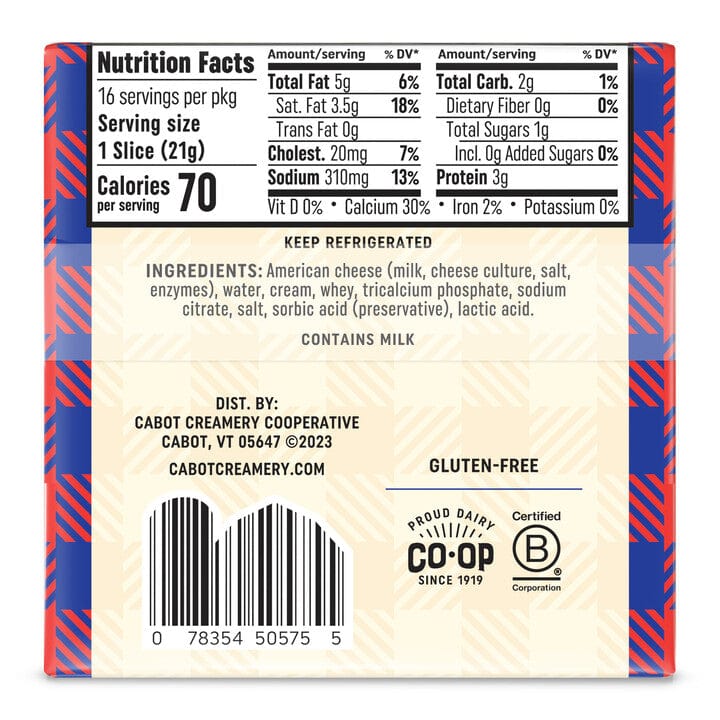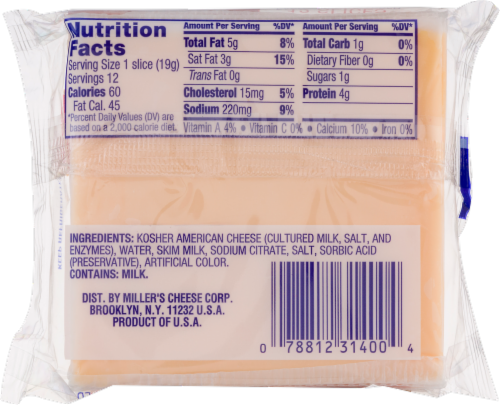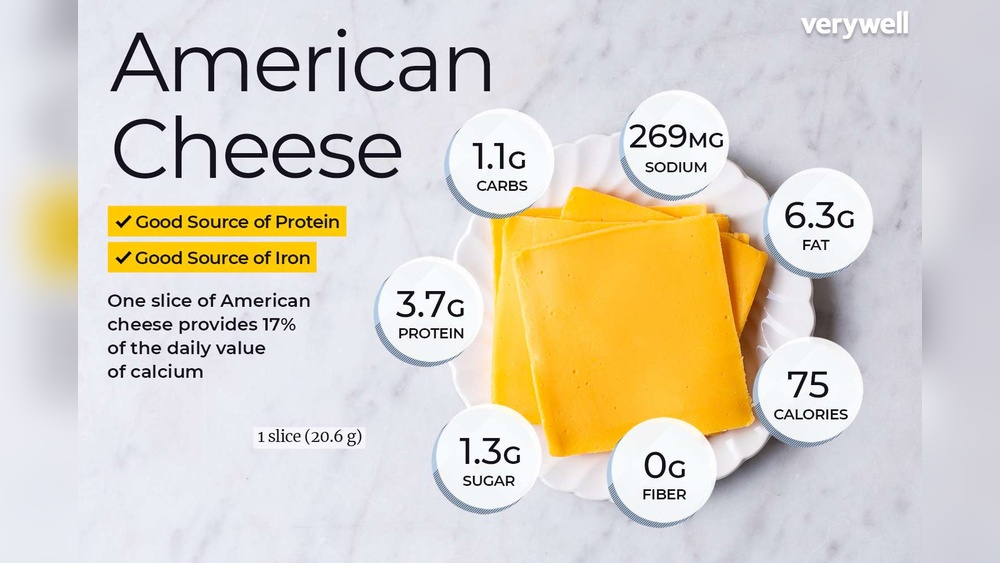Are you curious about what’s really inside your favorite American cheese slice? Whether you enjoy it melted on a burger or simply as a quick snack, knowing the nutrition facts can help you make smarter choices for your health.
This article breaks down the key details about American cheese slices in a simple way, so you can understand how they fit into your diet. Keep reading to discover the surprising facts that might change the way you think about this classic cheese.
Nutritional Profile
American cheese slices are popular in sandwiches and snacks. Understanding their nutritional profile helps you make better food choices. These slices offer a mix of calories, fats, proteins, and important nutrients. Let’s explore what each slice contains.
The nutritional profile shows how these slices fit into your daily diet. It highlights calories, macronutrients, vitamins, minerals, and sodium. This helps you balance taste with health.
Calories And Macronutrients
One slice of American cheese typically has about 60 to 70 calories. Most calories come from fat and protein. It contains around 4 to 5 grams of fat, including saturated fat. Protein content is about 4 to 5 grams per slice. Carbohydrates are low, usually under 2 grams. This makes it a moderate source of energy with a focus on fats and proteins.
Vitamins And Minerals
American cheese provides small amounts of vitamins like vitamin A and B12. Vitamin A supports vision and skin health. Vitamin B12 helps with nerve function and blood formation. The slices also contain calcium, important for strong bones and teeth. Other minerals like phosphorus may be present in smaller amounts. These nutrients add value beyond basic calories.
Sodium Content
One slice can have about 250 to 300 milligrams of sodium. This is roughly 10% of the daily recommended limit. Sodium helps with fluid balance but too much can raise blood pressure. People watching their salt intake should consider this when eating multiple slices. Moderation is key to enjoy the taste without excess sodium.

Credit: cabotcreamery.com
Ingredients Breakdown
Understanding the ingredients of American cheese slices helps you know what you eat. The ingredients affect flavor, texture, and nutrition. This section breaks down what is inside these popular cheese slices.
Different types of cheese and additives make a big difference. Let’s explore the details to see how they impact your health and diet.
Processed Vs. Natural Cheese
American cheese slices often use processed cheese. Processed cheese mixes natural cheese with other ingredients. It melts easily and lasts longer on shelves.
Natural cheese contains just milk, salt, and enzymes. It has fewer additives and a stronger taste. Processed cheese has more uniform texture but less natural flavor.
Additives And Preservatives
Many American cheese slices include additives like emulsifiers. These keep the cheese smooth and prevent separation. Preservatives help extend shelf life by stopping bacteria growth.
Common additives include sodium citrate and sorbic acid. These are safe in small amounts but increase sodium content. Check labels to see what additives are inside.
Impact On Nutrition
Processed cheese slices often have higher sodium and fat. They also contain less protein than natural cheese. Additives can reduce some nutrients but improve texture and shelf life.
Choosing cheese with fewer additives means more natural nutrients. Balance is key for a healthy diet. Portion control helps manage calorie and fat intake.
Health Benefits
American cheese slices offer several health benefits that contribute to a balanced diet. They provide essential nutrients that support various bodily functions. Including these slices in meals can help meet daily nutritional needs.
Protein And Calcium Sources
American cheese slices contain a good amount of protein. Protein helps build and repair muscles. It also supports the immune system.
These slices are rich in calcium. Calcium is vital for strong teeth and bones. It also aids in muscle function and nerve signals.
Bone Health Support
The calcium in American cheese slices helps keep bones healthy. Regular calcium intake lowers the risk of bone disorders. It is especially important for growing children and older adults.
Vitamin D, often added to cheese, improves calcium absorption. This combination supports better bone density and strength.
Energy Contribution
American cheese slices provide energy through fats and proteins. These nutrients fuel the body for daily activities. They help maintain steady energy levels throughout the day.
Including cheese in meals can make snacks more satisfying. This helps prevent quick hunger and supports balanced eating habits.

Credit: www.kroger.com
Potential Health Concerns
American cheese slices are popular and convenient, but they come with some health concerns. Knowing these risks helps you make better choices. Some ingredients and nutrients in these slices may affect your health over time. Pay attention to what you eat.
High Sodium Risks
American cheese slices often contain a lot of sodium. Eating too much sodium can raise blood pressure. High blood pressure increases the chance of heart problems. People with heart conditions should watch their salt intake carefully. Cutting down on sodium helps keep your heart healthy.
Saturated Fat Effects
These cheese slices usually have high saturated fat. Saturated fat can raise bad cholesterol in the blood. High cholesterol may lead to clogged arteries and heart disease. Limiting saturated fat is important for heart health. Choose lower-fat options when possible.
Allergens And Sensitivities
American cheese slices contain milk and other dairy ingredients. People with lactose intolerance may feel discomfort. Some might have allergies to milk proteins. Check labels for additives or preservatives that cause reactions. Avoid these slices if you have dairy allergies or sensitivities.
Comparisons With Other Cheeses
American cheese slices stand out among many types of cheese. Comparing them with other cheeses reveals clear differences. These differences affect nutrition, taste, texture, and cooking uses. Understanding these points helps in choosing the right cheese for your needs.
Nutrition Differences
American cheese slices often contain more sodium than natural cheeses. They have moderate fat and calorie content. Natural cheeses like cheddar or mozzarella usually have less added ingredients. They offer more protein and calcium per serving. Processed American cheese may include preservatives and emulsifiers. This changes its nutritional profile compared to fresh cheeses.
Taste And Texture Variations
American cheese has a mild, creamy flavor. It melts smoothly and feels soft in the mouth. Other cheeses like Swiss or gouda have stronger, sharper tastes. Their textures vary from crumbly to firm. American cheese’s uniform texture comes from processing. This makes it less complex but very consistent.
Usage In Cooking
American cheese slices melt evenly, perfect for burgers and sandwiches. Their smooth melt helps create creamy sauces and soups. Hard cheeses like Parmesan add flavor but do not melt as well. Soft cheeses like brie can melt but change texture more. American cheese’s convenience suits quick, easy meals.

Credit: pearlvalleycheese.com
Tips For Healthier Choices
Choosing American cheese slices wisely can improve your diet. Small changes make a big difference. Focus on smart habits to enjoy cheese without guilt. Here are some tips for healthier choices.
Reading Labels
Check the nutrition facts on the package. Look for lower sodium and fat content. Choose slices with fewer additives and preservatives. Watch out for artificial ingredients. Simple labels often mean better quality.
Portion Control
Limit the number of slices you eat at once. One or two slices can satisfy your craving. Avoid eating cheese alone; pair it with vegetables or whole grains. Smaller portions help manage calorie intake. Balance is key to enjoying cheese daily.
Alternatives To Consider
Try natural cheeses like mozzarella or cheddar. These options often have less processing. Plant-based cheese slices can be a good choice too. Look for versions made with nuts or soy. Experiment to find what tastes good and feels healthy.
Frequently Asked Questions
What Are The Calories In An American Cheese Slice?
An American cheese slice typically contains about 60 to 70 calories. It is a moderate-calorie snack, making it easy to include in balanced diets.
How Much Protein Does American Cheese Provide?
Each slice of American cheese provides around 4 to 5 grams of protein. This helps support muscle repair and daily protein needs.
Is American Cheese High In Sodium?
Yes, American cheese slices are relatively high in sodium, averaging 300 to 400 mg per slice. Moderation is key for sodium intake.
Does American Cheese Contain Essential Vitamins And Minerals?
American cheese contains calcium and vitamin A, which support bone health and vision. However, it is not a significant source of other vitamins.
Conclusion
American cheese slices offer a mix of nutrients and calories. They provide protein and calcium but also contain fats and sodium. Knowing these facts helps you make better food choices. Enjoy them in moderation as part of a balanced diet.
Simple awareness supports healthier eating habits every day. Choose what fits your taste and health needs best.

